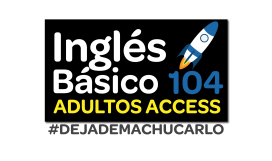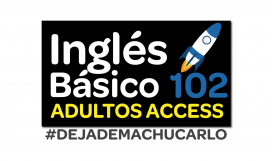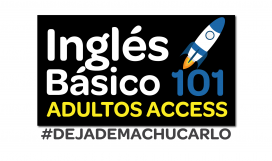Inglés Básico Adultos Access 103

El Inglés Básico Adultos Access 103 es un programa diseñado para mayores de 17 años. Es el tercer nivel básico de nuestro programa (como requisito debe haber completado el nivel 2 o tomar examen de nivel). Este combina los elementos fundamentales del idioma de forma puntual de modo que el estudiante sea capaz de utilizar el vocablo de inmediato. A partir de este momento, todo el contenido disponible será en inglés pues estaremos utilizando la metodología de aula invertida y el método comunicativo.
La metodología de aula invertida o Flipped classroom es la concepción de que el alumno puede obtener información en un tiempo y lugar que no requiere la presencia física del profesor. Se trata de un nuevo modelo pedagógico que ofrece un enfoque integral para incrementar el compromiso y la implicación del alumno en la enseñanza, haciendo que forme parte de su creación, permitiendo al profesor dar un tratamiento más individualizado. Por consiguiente, usted verá el contenido antes de su encuentro con el profesor.
Ventajas de esta metodología:
- Usted es el protagonista
- Uso de tecnología y plataformas web
- Consolida el conocimiento
- Favorece la diversidad en el aula
- Aprendizaje más profundo y perdurable en el tiempo
- Mejora el desarrollo de las competencias por el trabajo individual y colaborativo
Esto permite que los encuentros sean más enfocados en la parte oral, haciendo uso del método comunicativo o CLT, que es un enfoque en la enseñanza de idiomas donde se prioriza la interacción oral del lenguaje.
Bienvenido al mundo bilingüe!
Lesson 14A
These are objectives of lesson 14A. These are the topics that you are going to lean after you finish this lesson.
In this activity you will need to watch a video with a short explanation of the simple past, how to form sentences and pronounce the verbs correctly.
In this activity you will need to watch a video with a short explanation of the simple past and answer the questions at the end.
In this activity you will need to watch the video to learn the correct pronunciation of the verbs in the simple past, and practice along the video.
In this activity you need to speak the correct pronunctiation of some regular verbs in the simple past form.
In this activity you need to download a chart with a list of the most used irregular verbs (present and past).
In this activity you will need to drag the correct past form for these verbs.
In this activity you will need to complete the conversations with the prompts above.
In this activity you will need to complete the sentences with the correct form of the simple past of the verbs in the list.
In this activity you will need to complete the sentences with the negative form of the verbs in simple past.
In this activity you will need to watch a video with some household chores vocabulary to learn and practice.
In this acrivity you will need to change the sentences into the simple past tense correctly.
Lesson 14B
Here you have the objectives of lesson 14B. It is a list with the topics that you are going able to learn after finishing the lesson.
In this activity you will need to study these cards to learn some common summer activities.
In this activity there's a short video you will need to watch with an explanation on how to form questions in the simple past tense.
In this activity you will need to guess the sumemr activity based on the picture in the flashcard.
In this activity you will need to change these sentences into the interrogative form of the simple past tense.
In this activity you will need to form questions in the simple past tense with the verbs in parenthesis.
In this reading comprehesion activity you will need to read a short biography and answer some questions afterwards.
This is a quiz to test what you learned in lessons 14A and 14B.
Lesson 15A
These are the objectives of lesson 15A, which includes how to use the past of the verb 'be' and how to talk about one's personal history.
In this activity you will need to watch a video to learn how to use the simple past form of the verb 'be'.
In this activity you will need to change a bunch of sentences in the simple past form.
In this activity you will need to complete the sentences using the simple past form of the verb 'be'.
In this activity you will need to watch a video explaining how to say the years correctly.
In this activity you will need to make sentences saying the years these people were born based on the pictures.
Lesson 15B
These are the objectives of lesson 15B.
In this activity you will need to watch a video that shows you school subjects and class vocabulary.
In this activity you will need to look for the school subjects and classes vocabulary in the grid.
In this activity you will need to drag the subjects names and drag them onto the correct pictures.
In this activity you will need to watch a video with a short explanation on how to form wh-questions in the simple past tense.
In this activity you will need to drag the correct wh-word to the questions to complete the conversations.
In this exercise you will need to read a text about someone's childhood memories and then complete some activities.
Lesson 16A
These are the objectives of lesson 16A, which include the topics you are going to learn in the lesson.
In this activity you will need to watch a video with a short explanation on how to use the object pronouns.
In this activity you will need to answer the questions within the video.
In this activity you will need to choose the correct object pronoun to complete the sentences.
In this activity you will need to change the parts in bold into an object pronoun.
In this activity you will need to watch a video that teach you how to answer and hold an everyday phone call conversation.
In this activity you will need to watch a video that will teach you how to handle a telephone call.
In this activity you will need to watch a video that will show you some of the most useful prepositional phrases in English.
In this activity you will need to complete the sentences using the correct prepositional phrase.
Lesson 16B
These are the objectives of lesson 16B, which includes topics such as: making and accepting invitations.
In this activity you will need to watch a video that will show different ways to make invitations to people you know and people you do not know.
In this activity you will need to watch a video that teach you how to make invitations to other people, as well as how to accept and/or decline them.
In this activity you will need to to complete the sentences with the words and phrases in the boxes.
In this activity you will need to choose the correct answer to accept or refuse the invitations.
In this activity you will need to read a conversation of a person inviting someone to a party and then answer some questions.
This a quiz to test your knowledge of lessons 16A and 16B.
B1 Lesson 1A
These are the objectives of lesson 1A, which explain the topics that you are going to be able to learn after you finish the lesson.
In this lesson you will need to watch a video of two people meeting and introducing themselves for the first time.
In this lesson you will need to watch a video with two people having a conversation meeting for the first time.
In this lesson you will need to complete the conversations choosing the correct answer.
In this lesson you will learn some common and basic questions that are used to get information from people you're intereseted in.
In this lesson you will need to watch a video that will teach you how to sound more natural using elision in everyday English conversations.
In this lesson you will need to watch a video that will teach you how to sound more natural using connected speech in everyday English conversations.
In this lesson you will need to watch a video that will teach you how to use verb to be contractions.
In this lesson you will need to write the contraction forms of the verb be.
In this lesson you will need to watch a video that shows you how to use WH-questions in a normal everyday conversation.
In this lesson you will need to complete the conversation based on the answers given dragging the words and phrases.
B1 Lesson 1B
Here's the list of topics you are going to learn at the end of this lesson (B1 lesson 1B).
In this lesson you will need to watch a video that shows you 10 different ways to say 'hello' in everyday spoken English.
In this activity you will need to watch a video that will teach you different ways to say good-bye in English for everyday conversation.
In this activity you will need to drag the greetings under the correct category (hello and good bye).
In this activity you will need to watch a video that teaches you some of the most common subjects learned in school as well as what they're about.
In this activity you will need to watch a video that shows different people expressing what their favorite subjects is/was in school.
In this activity you will need to watch a video and transform sentences into yes/no questions within the video.
In this activity you will need to change some sentences into yes/no questions.
In this activity you will need to form yes/no questions from sentences and then answer with a positive response and a negative one.
This is a short quiz to test your knowledge on the topics learned throughout lessons 1A and 1B.
B1 Lesson 2A
These are the topics you are going to be able to learn in the lesson 2A.
In this activity you are going to need to watch a video with some jobs and occupations vocabulary names.
In this activity you will need to watch a video that will teach you jobs & occupations vocabulary and explain what they're about.
In this activity you are going to need to watch a video with some jobs and occupations vocabulary names.
In this activity you will need to study the cards with the professions and jobs vocabulary. They have a picture and the name of the job for you to practice.
In this activity you will need to guess the names of the jobs based on the pictures shown in the flashcards.
In this activity you will need to watch a video about common part-time jobs in the U.S. and complete an exercise afterwards.
In this activity you will need to watch a video that will show you different ways to ask about people's job.
In this activity you will need to read the word that is shown and, using your microphone, read the word aloud with the correct pronunciation.
B1 Lesson 2B
These are the objectives of B1 lesson 2B, which includes topics such as: prepositions of time, how to describe rutines and schedules.
In this activity you will need to watch a video that teaches how to use the prepositions of time: 'in', 'at' and 'on'.
In this activity you will need to complete a group of sentences with the correct prepositions of time (in, at, on).
In this activity you will need to watch a video about the prepositions of time and complete the questions.
In this activity you are going to need to complete a group of sentences choosing the correct preposition (in, at, on).
In this lesson you will need to watch a video that teaches you how to use time expressions in the present.
In this activity you will need to watch a video that will show two characters talking about their daily routine.
In this activity you will need to complete the sentences draggin the correct words.
In this activity you are going to need to complete the text dragging the corresponging verb to the boxes.
In this activity you are going to need to read a text describing a person's daily routine and complete some exercise afterwards.
This a quiz to test your knowledge on Lesson B1 2B.
B1 Lesson 3A
These are the objectives of B1 lesson 3A, which include topics such as: demonstrative pronoun and how to ask for prices.
In this activity you are going to need to watch a video that will show you how to ask for prices at a store.
In this activity you are going to need to watch a video that shows two characters talking at a store and follow some activities within the video.
In this activity you are going to need to watch a video that will teach you how to use the demonstrative pronouns (this-that, these-those).
In this activity you need to complete the sentences using the correct demonsttative pronoun (this-that, these-those).
In this activity you are going to need to watch a video that wil teach you the rules to form nouns into the plural form.
In this activity you are going to need to complete a plural nouns practice choosing the correct answer for each word.
In this activity you are going to need to write the correct plural form of the nouns listed.
B1 Lesson 3B
These are the objectives of B1 lesson 3B, which include topics such as: how to use comparative adjectives and how to describe clothing materials.
In this activity you will need to watch a video that will explain the rules to use comparative adjectives properly.
In this activity you will need to complete the blank space with the correct comparative adjective, and after that you should read outloud the examples provided.
In this exercise you have to fill the blank spaces with the correct comparative adjectives.
In this activity you are going to need to complete the sentences with the correct comparative with the adjectives in parenthesis ().
In this lesson you will have to watch a video to learn how to talk about preferences between different items.
In this lesson you will watch a video of a conversation in a clothing store about clothing preferences.
In this activity you will have some cards with information to learn the different clothing fabrics and materials with some of their characteristics.
In this activity you will be able to see some pictures and answer what type of material/fabric they are.
This is a short quiz to test your adquired knowledge on lessons B1 3A and 3B.
B1 Lesson 4A
These are the objectives of B1 Lesson 4A, which include topics such as: types of music and movies, intonation and how to talk about personal preferences.
In this activity you will need to study the different music styles by reading their definition and listening to a music sample.
In this activity you are going to need to search the music style names in the grid.
In this activity you are going to need to watch a video that teaches you the correct intonations for questions in English.
In this activity you are going to need to watch a video that will show you the difference in questions intonation.
In this activity you are going to need to look at the pictures and listen to the pronunciation of the movie types vocabulary.
In this activity you are going to need to guess the type of movie based on a picture in a flashcard.
In this activity you are going to need study a group of TV shows vocabulary cards, which have a picture and short description for you to learn.
In this activity you are going to need to guess the TV show type by looking at a picture on group of flashcards.
In this activity you are going to need to watch a video that shows you how to speak about things you like and things you don't like.
In this activity you are going to need to read a short text about somebody's entertainment preferences and then answer some exercises.
B1 Lesson 4B
These are the objectives of lesson 1B, which include topics such as: How to use the auxiliary verb Would, accepting/declining invitations with would and some of the most popular abbreviations used online.
In this activity you will learn the use of the auxiliary verb "would" and apply them on invitations, conversations and situations that require politely asking for something.
In this activity you will have to arrange and organize the sentence in the correct order. All sentences are using the auxiliary verb "Would".
In this activity you will have to select the correct answer using Would. Verify the use of short and long versions of the verb Would.
In this activity you are going to need to listen to a conversation and then answer some questions about it.
In this activity you will learn the different abbreviations used in online conversations and text messaging.
In this activity you will watch a video to learn about some of the most used online abbreviations used on chats and text messaging.
In this activity you will have to complete the spaces with the correct long form of the abbreviation. You will expand your "online written vocabulary" and learn to use them in your daily life.
This is a short and simple quiz to test your knowledge on Lessons 4a and 4b.




